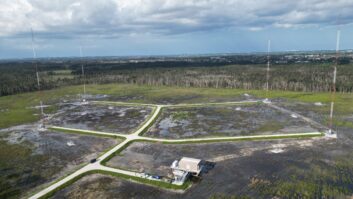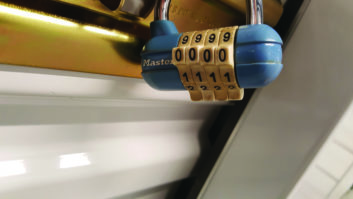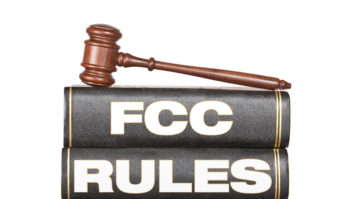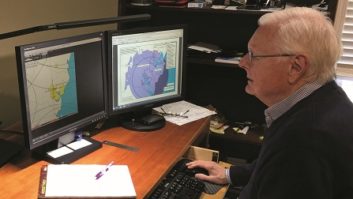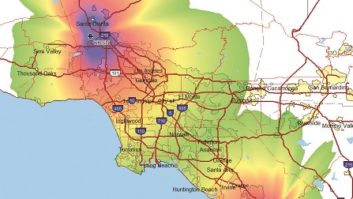Over the past couple of years, we have circled back around to the topic of translators with great regularity. This month will be no exception. My ramblings this time will consist of a medley of assorted topics pertaining to translators.
The make, model and directional characteristics for translator antennas are application-specific, like the example shown, and cannot be changed in the construction phase. A year ago, we discussed AM revitalization. At that time, the ink was still a little damp on the commission�s first serious attempt at this topic in a quarter of a century. While quite a few of the significant changes to the AM rules ran into a buzz saw, the translator prong of that order has hummed along quite nicely. It is perhaps a universal truth that the use of translators by AM stations has been a boon. The commission�s waiver of its rules to permit the relocation of translators, both spectrally and geographically, has opened up many opportunities.

Within the first of these windows, which ran from Jan. 29 to July 28, nearly 900 construction permit applications of all flavors were filed. Participation in this first window was restricted to licensees of Class D and Class C AM facilities. The second window, which ran from July 29 to Oct. 31, had a more robust daily participation level with around 800 applications filed. In this second window, stations of any class could file if they had not already filed in the first grouping.
The second of the two-prong approach allows for filing of applications for new translator authorizations. This also proposes a Class C/D grouping initially, and then a second opportunity for those not filing in the first. While the AM Revitalization Order indicated 2017 as the time frame for the submission of window applications, it does not appear that the staff has any more definitive date than 2017.
TIMING
In fact, as footnote 39 in the order indicates, this forthcoming filing window, which will be an auction window, is to occur after the completion of Auction 83, the Incentive Auction and Auction 1000. Auction 83 is not yet scheduled, and it remains to be seen how many additional stages the Incentive Auction will require.
So, reading between the lines, $5 says the probability of observing airborne swine in the first quarter of 2017 is higher than that of filing in the next translator windows during the same period.
(It should be noted that the text of the order says ��beginning in 2017,� so as long as the first of the upcoming auction windows is open by the next time we sing �Auld Lang Syne�, nothing is technically amiss.)
As was the case in the modification windows during 2016, the timing of participation in the upcoming auction windows will be determined by AM station license class. Class C and D facilities will have the opportunity to file in either window, while Class A and B facilities will have to wait until the second. In all likelihood, the second of these auction windows will not be able to open immediately after the first, as was the case last summer.
The second auction window is to open �as soon as possible� after the close of the first auction window, and after the resolution of mutual exclusivities from the first window. Note that some mutual exclusivities remain unsolved between applications filed in the last auction window, which was in 2003.
ANTENNAS
Keep in mind that, when filing for a construction permit for a translator, it is necessary to specify the antenna make and model. This is different from applications for full-power FM stations, which generally are antenna model neutral.
One notable exception where FM antenna models are specified is in cases when RF radiation exposure as calculated through FM model becomes a problem. Since the make and model of translator antennas are specified at the construction permit stage, it is not an acceptable practice to swap out antennas when the facility is constructed, unless the construction permit is modified through another application.
While on the surface this might seem excessive for a simple translator, it is precisely because it is a translator that the antenna model specification is necessary. The root methodology for demonstrating adequate interference protection to other facilities on paper is the standard contour overlap model. If a proposed facility meets the contour overlap standards under Section 74.1204 of the commission�s rules, it is �grantable.�
CONTOUR MAPS
Recall a couple of important things about FCC contours. First, they are based on the average terrain between 3 and 16 km (or 2 and 10 miles, if you prefer) from the transmitter site. Whatever happens outside of that range is ignored, and whatever happens inside is boiled down to a single average value. So, while they work pretty well where the terrain varies somewhat, if you go to the extremes like a mountainous area, or on the other hand a coastal area, their predictions can fall apart.
Secondly, an area of contour overlap is not necessarily the same as an area of interference. Rather than being the result of contour overlap, interference more accurately occurs at a location when a particular ratio between a desired signal and an undesired signal is not achieved. Section 74.1204(d) recognizes this, and as a result allows for normally prohibited contour overlap if it lies entirely over water, or can be demonstrated that no actual interference would will occur.
The two specific examples given are intervening terrain and lack of population. Lack of population as a factor should be self-evident. No interference region, regardless of its scope, will be observed, or for that matter, will be of importance, if it has zero population. Similarly, intervening terrain will prevent an offender from causing interference in some region by shadowing its transmitted signal. Even without large bodies of water or terrain shielding, in many cases, it is not overly difficult to steer an interference region away from population.
The idea is to use the vertical and/or horizontal pattern of the translator antenna to steer the predicted interference region away from populated regions.
For instance, two-bay antennas with full-wave, half-wave, and 0.7 wavelength spacings all have different radiation characteristics in a vertical plane. With simple trigonometry and calculations based on the definition of an isotropic radiator combined with an application of Poynting�s theorem, we can determine the border of the predicted interference region relative to the antenna location. If it can be demonstrated that no population resides within this region, then the staff will likely grant a construction permit. This type of analysis typically can only be used in second and third adjacent situations.
GRANTABLE AND SURVIVABLE
Translators are, of course, a secondary service. As such, they are generally only permitted to cause actual interference to the reception of subsequently authorized FM translators. In other words, translators get squatter�s rights with regard to the transmissions of subsequently authorized translators, but when considered against other facilities and situations, are always the problem. This secondary nature dictates that a translator must be considered in terms of what is �grantable� and what is �survivable.�
This situation is especially critical when considering translators represented as having large footprints in densely populated areas, yet are co-channel or first-adjacent channel to full-power �rim shots� or external market stations. In many of these cases, the marketing materials will show the 40 dBu interfering contour of the translator tangential to the 60 dBu service contour of one or more full-power FM facilities.
It goes without saying that coverage of a full-power FM station is rarely confined to its 60 dBu service contour, and so despite lack of prohibited contour overlap, which makes the translator grantable, said translator may not be survivable because of the almost certain large area of actual interference that will result.
In short, special consideration should be given to any co-channel or first-adjacent translator where the predicted interfering contour is tangential with service contour of a nearby full-power facility. Such cases are ripe for large numbers of complaints, and if more recent than the full-power FM authorization, not a candidate for displacement relief.
WAIVERS
Displacement relief is in some cases allowed by the staff. The idea is that if an FM station comes on line, and as a result of its startup, creates prohibited contour overlap with an existing translator, the translator can request a change to a non-adjacent channel. In order to qualify for such relief, the displaced translator must demonstrate that no adjacent channel is available. Adjacent channels are those considered to be within three channels of the current channel, or on the intermediate frequency split of 53 or 54 channels from the current channel.
Displacement is technically a waiver of the commission�s rules. The other waiver currently allowed, but which in the future may be terminated, is the Mattoon Waiver.
The Mattoon Waiver has three specific criteria of no history of serial modification applications, mutual exclusivity between proposed and licensed facility and proposed rebroadcast of AM station. In return for granting this waiver, which the commission has directed the Media Bureau to continue, there is a four-year holding requirement under which the primary AM station may not be changed. The verdict is still out on the more aggressive Tell City Waiver, which proposes relocation within the 0.25 mV/m contour of the primary AM station, thereby relaxing the second prong of the Mattoon Waiver. That procedure, while under review, was originally denied by the Media Bureau.
And so, as we roll into 2017, translators are still very much on the front burner of activity. There is keen interest in their use both for AM stations and for providing fill-in service for IBOC streams of FM facilities. Opportunities remain for the acquisition of translators, especially for AM stations; however, that door will eventually close most of the way, as all doors tend to do.





